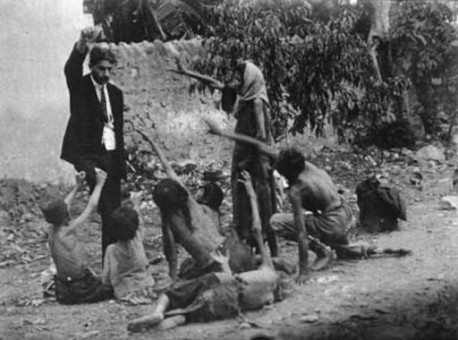Hundreds attend a service at the Armenian Church of the Holy Cross, the first held there since 1915, when a wave of violence nearly destroyed one of the largest Christian communities in the Middle East.
Most visited the small church for a few minutes and watched the ceremony via giant television screens set up in the gardens outside. (Mustafa Ozer / AFP / Getty Images)
A Sunday service at a historic church in eastern Turkey underscored both the desire for reconciliation between Turks and Armenians and the hurdles that remain nearly a century after a violent massacre of Armenians.
It was the first service held in the 1,100-year-old Armenian Church of the Holy Cross since 1915, when a wave of violence nearly destroyed one of the largest Christian communities in the Middle East.
Many Armenians in the diaspora and the neighboring republic of Armenia boycotted and denounced Sunday’s service on Akdamar Island after Turkish authorities did not allow a cross to be raised on the dome of the church. It was placed on the church grounds instead.
Still, hundreds of Armenian pilgrims attended, many coming from the relatively large Armenian community in Istanbul, Turkey’s main city, but also from Iran, Germany, France and from as far away as the United States. They flooded local hotels and sang hymns as they traversed Lake Van by boat to get to the site.
“There is a village far, far away,” one group sang. “It’s my village even though I never go or I haven’t seen it.”
Most visited the small church for a few minutes and watched the ceremony via giant television screens set up in the gardens outside.
“I feel bittersweet about being here, because I grew up hearing about the life in Van from my parents,” said Paul Shahinian, a 58-year-old visiting from New Jersey. “I always had images in my head about Van. I never imagined I could come here because Turkey didn’t welcome Armenians.”
The church, surrounded by verdant mountains and hills, is decorated on the outside with carvings of animals such as peacocks, goats and owls, which are common in Armenian iconography. Paintings inside are meant to represent the heavens.
“This church, which is a valuable piece of art, is a cultural monument that belongs to the whole of humanity,” Archbishop Aram Atesyan of the Armenian Patriarchate of Turkey said during a two-hour service he led, according to Turkey’s official Anatolian news agency.
The 8-year-old government of Prime Minister Recep Tayyip Erdogan has strived to heal the wounds of the past by reaching out to Armenians in Turkey and abroad in an attempt to bolster its international reputation and smooth out obstacles to possible Turkish entry into the European Union. In 2005, Turkey began a $1.5-million restoration of the church, opening it as a museum in 2007. It will host an annual religious service from now on.
Some critics, both in Turkey and among Armenians, have denounced the handling of the church opening as an attempt by Turks to whitewash a violent history. But others describe the Sunday event as an important gesture by an activist Turkish government that appears more ready and able than previous political elites to address the country’s domestic and international sore spots.
But attempts at reconciliation between Armenians and Turks have often faltered, as much over misunderstandings of gestures as substantive differences, the latter including Turkey’s refusal to abide by the widely accepted description of the killings as genocide.
The cross controversy underscores the sensitivity of relations between Turks and Armenians, even over relatively minor matters. Turkish officials blamed the church’s Italian architect, saying the dome could not support the 440-pound cross. The provincial governor of Van has promised that a cross would be mounted on the church within six weeks.
But many Armenians suspect continued chauvinism by Turks, who are governed by a political party that has roots in the country’s Islamist movements. “The cross wasn’t there because of the fears of the governments,” said Rafi Altunkeser, a 40-year-old Armenian Turk visiting from Istanbul.
But other Armenians called for reconciliation. Harry Parsekian, a Boston resident, said his family originally lived in eastern Turkey but was driven out. He first returned to the Van region in 1985 and has since gone back many times.
“When I was young I never imagined I would have Turkish friends,” Parsekian said. “But I do have really good Turkish friends now. And I believe this is a good step for the Armenians and Turks.”
daragahi@latimes.com
Special correspondent Saracoglu reported from Akdamar Island.
Copyright © 2010, Los Angeles Times
